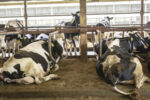Milk Quality
Understanding what influences milking speed, collecting and utilizing data can lead to improving milk speed.
Read More
Get mastitis treatment right the first time: The power of bacteriological cure
Reducing the bacterial load of a mastitis infection can be an effective treatment. Understanding the difference between a bacteriological cure and a clinical cure can help producers battle outbreaks.
Read More
Mythbusting teat dips: Are you using the right one on your dairy?
Know what to look for when selecting a teat dip to get the best results for your farm.
Read More
Teat health and milk quality: What should you be looking for?
Routinely collecting teat health metrics can help in assessing the impact areas on the farm for teat health.
Read More
Mastitis in fresh heifers: A major problem
Identifying if fresh heifers are contributing to a high somatic cell count can aid in increasing production levels.
Read More
How to ensure the highest milk quality and standards
Ensuring the highest milk quality and standards in a dairy operation involves a multifaceted and comprehensive approach with consideration for the various components of the milking system.
Read More
Do old genetics hold the key to reduced mastitis susceptibility?
Research shows that cells from a group of unselected Holsteins might hold the capability of reducing mastitis in modern cows.
Read More
Controlling bedding pathogens can reduce environmental mastitis
Recycled manure as bedding is an inexpensive and sustainable option. It is also an option that does not put the cows at greater risk for mastitis and higher somatic cell count when mastitis-causing pathogens can be safely and effectively controlled.
Read More
Butterfat 101: There’s more to it than nutrition
Several key nutrients to optimize maximum butterfat production and how your attitude can drive it.
Read More








